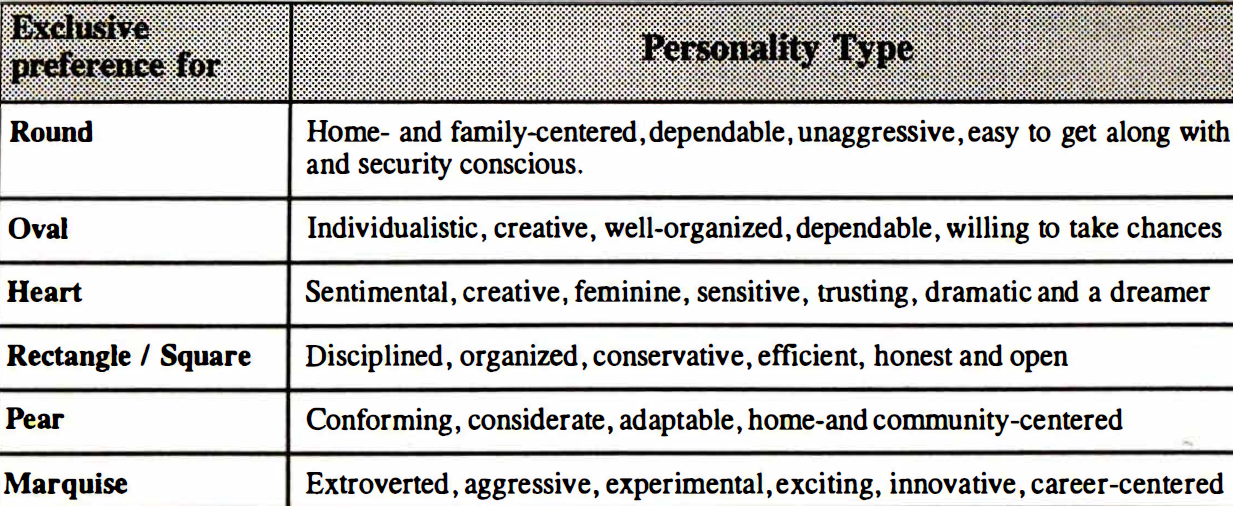The shape of a diamond not only affects how big and brilliant it looks, but it may even reveal personality traits of the buyer.
Saul Spero, a New York diamond appraiser and gem consultant, spent twenty-five years interviewing over 50,000 people and developing a system of predicting personality types mainly based on a person's first three preferences of diamond shapes. In his book Diamonds, Love & Compatibility, Spero discusses the six basic shapes-round, oval, pear, heart, marquise and square or rectangle. He states that if a woman has an exclusive preference for any of these shaped diamonds, she could be characterized as follows:
 |
| Figure 1 |
Please note that the personality profiles above are for women who like only one shape. Most women like more than one diamond shape, which is why Spero also evaluated personality types in terms of their second and third choices. A more complete discussion on diamond shape and personality can be found in Spero's book.
There are more than the six preceding shapes to choose from. Triangular shapes are very popular. You can also find stars, animals, Christmas trees, fish, fruit, boats and letters of the alphabet (Figure 2 and 3). Some people even have diamonds cut in the form of their state province or country. Stones with unusual shapes are sometimes called fantasy cuts.

|
| Figure 2 - A fantasy cut that's trademarked "Sculptaire." |
 |
| Figure 3 - Another fantasy cut |
Before you can thoroughly understand a discussion of diamond shapes and styles, some terminology must be explained. Here are some basic terms:
Facets - The flat, polished surfaces or planes on a diamond.
Table - The large, flat, top facet. It has an octagonal shape on a round brilliant diamond.
Beul Facets - Kite-shape facets on the crown of brilliant-cut diamonds. The star, pavilion mains, and upper and lower girdle facets are other facets found
on brilliant cuts (Figure 4).
 |
| Figure 4 - Facet arrangement of a standard round brilliant cut. Diagram reprinted with pennission from the Gemological Institute of America. |
Culet - The tiny facet on the pointed bottom of the pavilion, parallel to the table.
Girdle - The narrow rim around the diamond. The girdle plane is parallel to the table and is the largest diameter of any part of the stone.
Crown - The upper part of the diamond above the girdle.
Pavilion - The lower part of the diamond below the girdle. It's cone-shaped on a round diamond.
Brilliant Cut - The most common style of diamond cutting. The standard brilliant cut consists of 32 facets plus a table above the girdle and 24 facets plus a culet below the girdle (Figure 4). Other shapes besides round can be faceted as brilliant cuts.
Fancy Shape - Any shape except round. A pear shape is an example of a fancy shape. Sometimes fancy shapes are simply called fancies.
After knowing the above basic knowledge of diamond shapes, in next article I will have a quick review on cutting styles of diamonds. I will update the blog next Tuesday.
















































